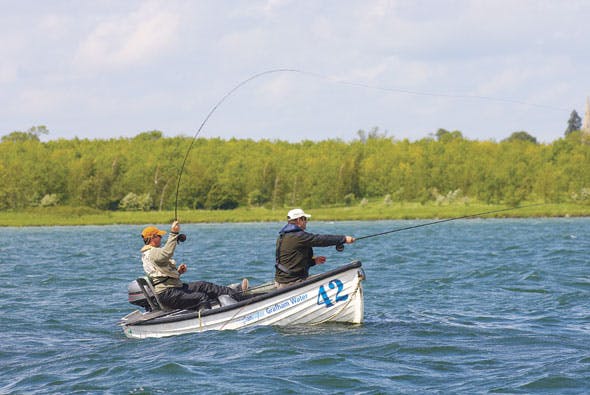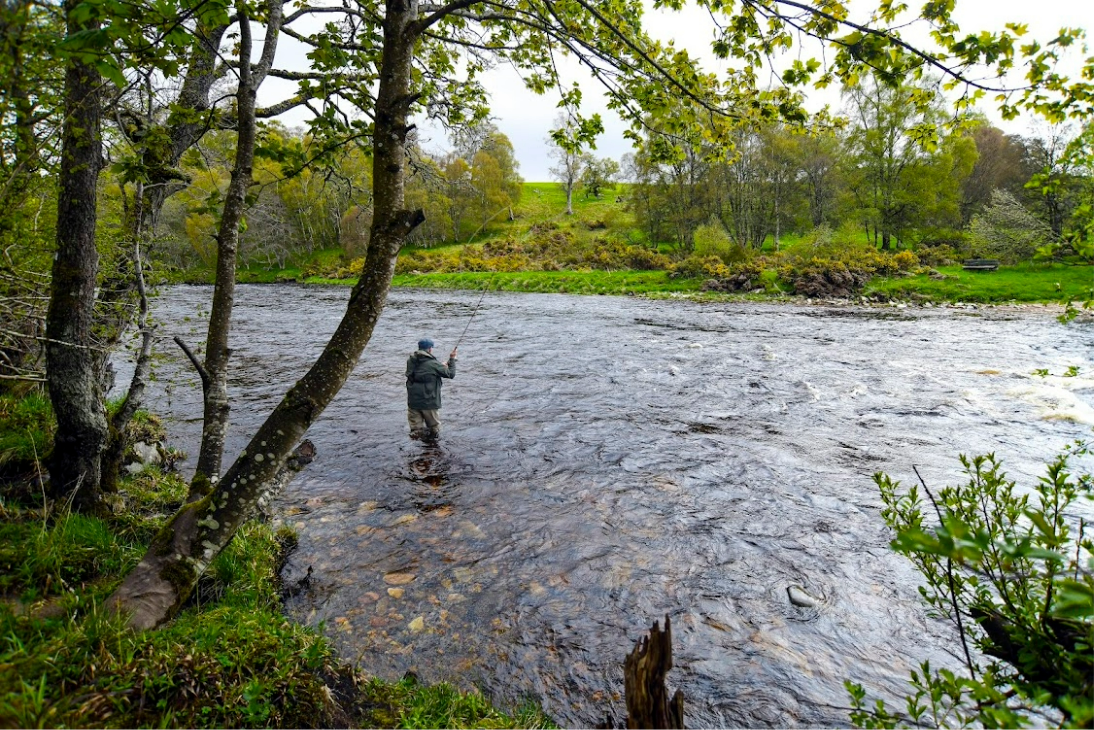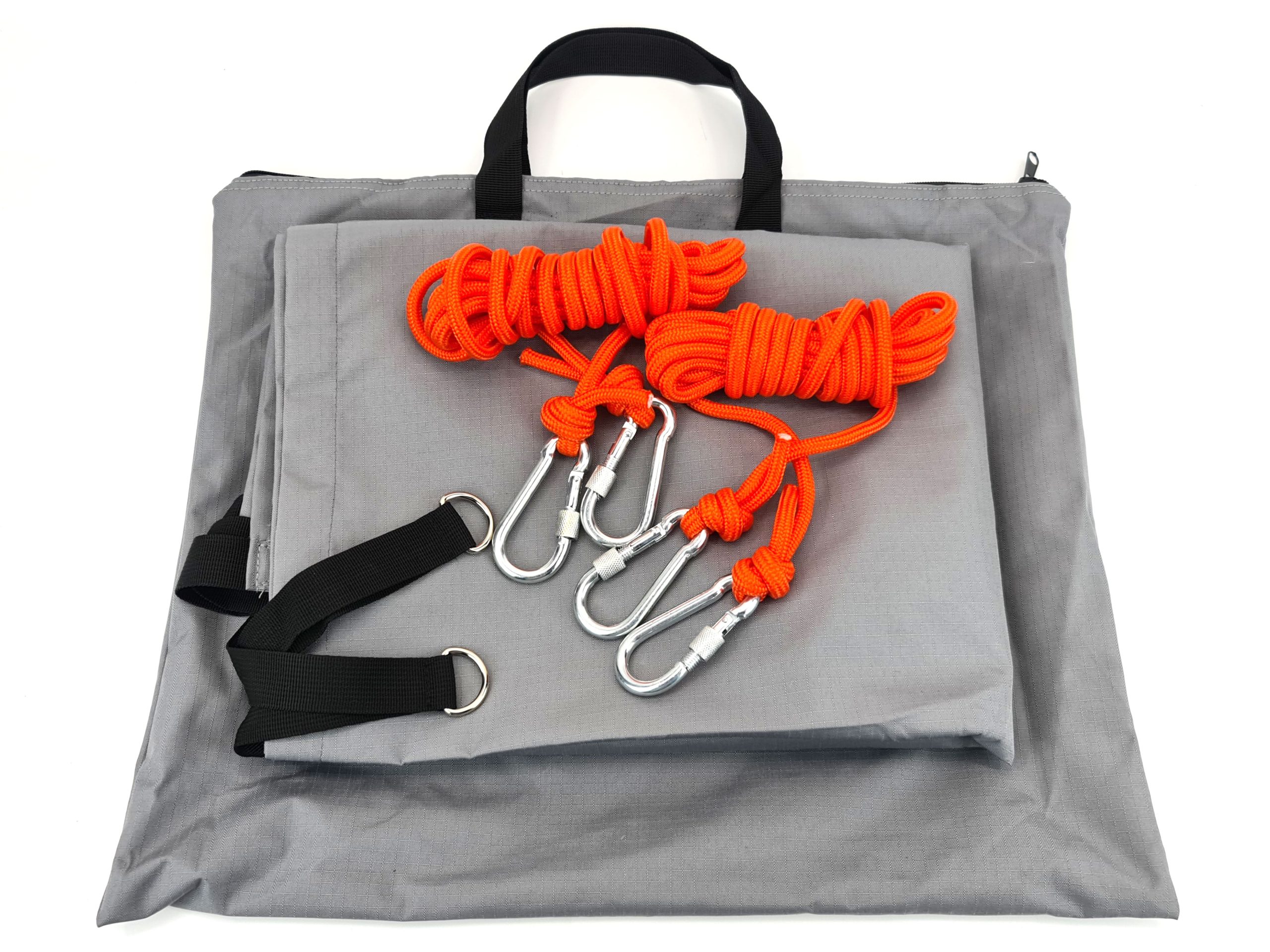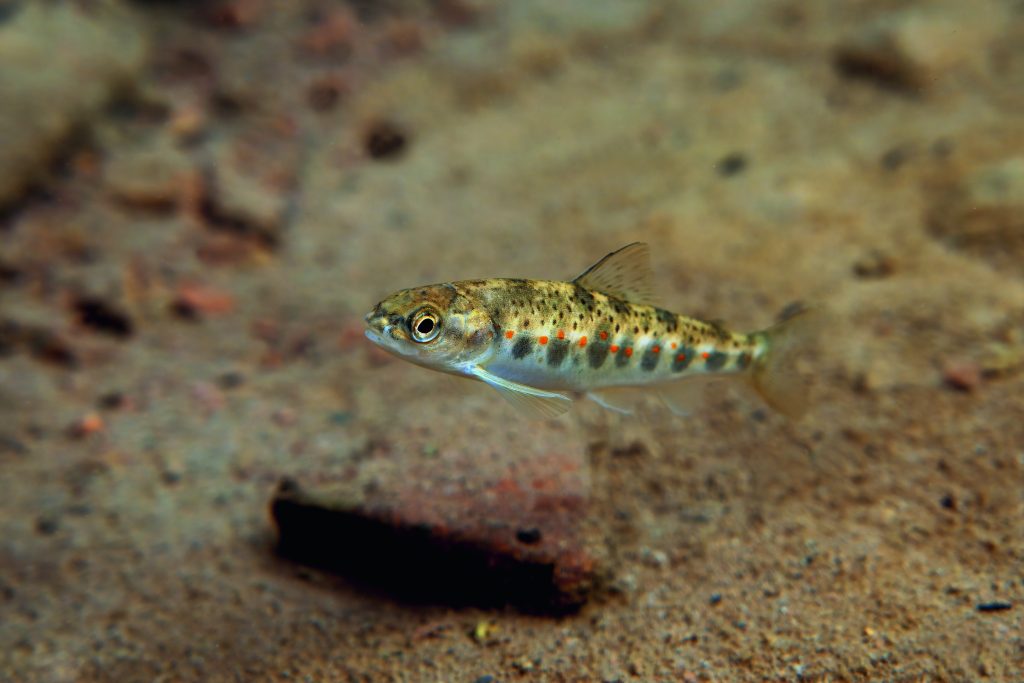TROUT FISHING AT THE RIGHT DEPTH USING SINKING FLY LINES
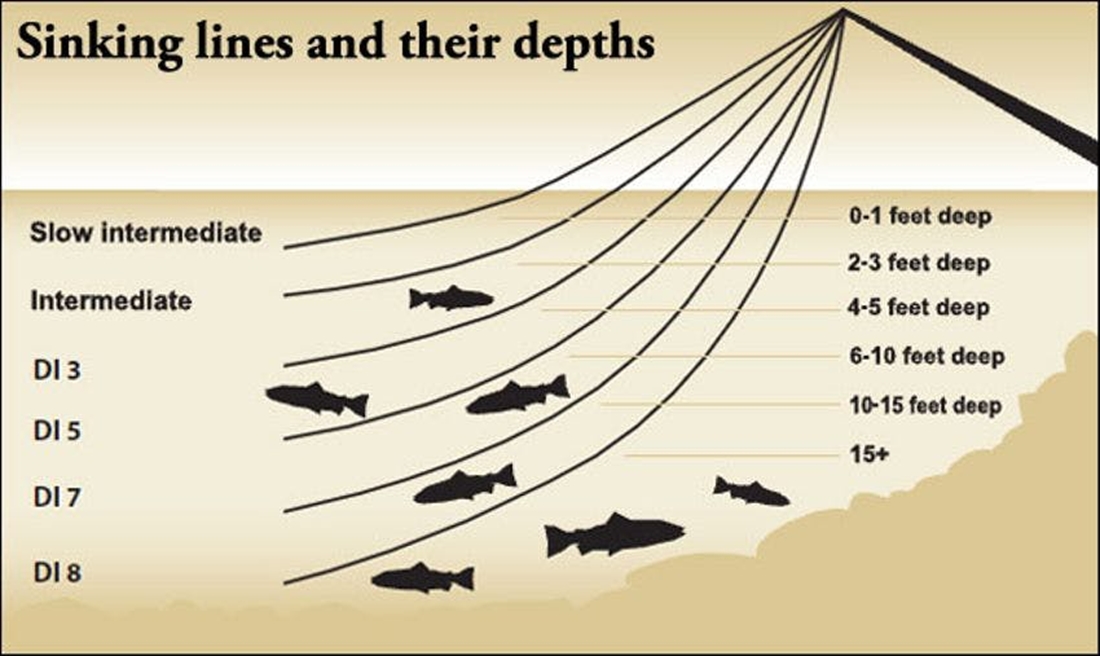
The correct fly and retrieve mean nothing if you’re not fishing at the right depth. Airflo’s Gareth Jones explains the importance of sinking lines and how he’s helped develop them…
WITH the reservoir trout fishing explosion in the 1970s, thousands experienced for the first time that electric moment when a fish first takes and remains, for a blissful few seconds, an unknown quantity – perhaps a stock rainbow but possibly a brown of great size and power.
Those early stillwater devotees may have fished with the best tackle available, but although they could not know it, their sinking lines were more of a handicap than an asset when measured against today’s hi-tech offerings.
Watching a newcomer trying to get a sinker airborne could be an embarrassment to both parties. Sadly, many novices abandoned any notion of improving their casting skills in favour of brute force and ignorance, aided and abetted by impossibly powerful rods. As for ‘presentation’, that was something for the dry fly brigade rather than the fluff-flingers with their Minkies and Zonkers. Something had to change to move the sport on.
But why use a sinking line in the first place? Trout follow their food up and down the water column, and the depth at which aquatic life forms are found changes according to the time of day, light levels and seasonality. Adaphnia bloom, for example, is least likely to be near the surface when the sun is at its brightest.
Sinking lines enable the angler to present a fly or lure at exactly the right depth and speed to capitalise on this natural larder. Afloating line, well, floats – but sinking lines can go down like a stone, remain just subsurface or be fished at all points in between. Armed with two or three lines of different densities, the angler can stay in contact with feeding trout wherever they happen to be.
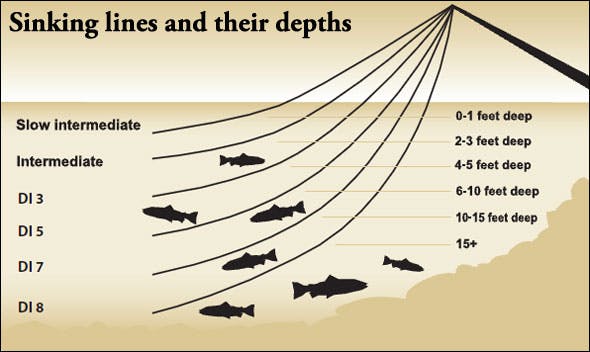
Tungsten breakthrough
WHEN we set out to make our original sinking fly lines more than 20 years ago, we focused on elements that would radically improve their performance – core stretch, sink path and durability were all elements we felt could be improved upon, but the most radical change was our decision to use tungsten, rather than lead powder, as a sinking agent. We were the first company to do this.
Tungsten, being far denser than lead, results in faster sinking fly lines, and is totally inert and environmentally-friendly.
Core stretch
WHEN fishing with a sinking line you seldom see the fish take the fly – you feel it. Unfortunately, the inherent stretch of 20-25 per cent in a regular sinking fly line with a braided multifilament core means that a lot of takes are never even registered. This led us to develop lines with Kevlar cores instead.
Kevlar, besides being bullet-proof, is completely non-stretch. This makes it great for casting, take detection and setting the hook. Its big drawback is a short working life and a tendency to develop a memory.
Instead of Kevlar, which we no longer use, we developed what we feel is now the ultimate fly line core – Power Core braid. This tightly woven multifilament polyester has only six per cent stretch and corresponding sensitivity. The material transmits casting energy/take detection better and is now the basis of most of our fly lines. In the heavier breaking strains, Power Core lines are ideal for use in saltwater, where setting large hooks at range is a priority.
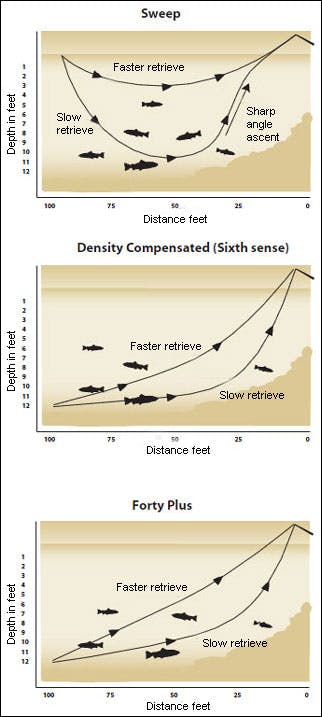
Density compensation
STILLWATER trout fishermen of 20 years ago suffered what might be thought of as a condition of these modern, sedentary times – belly sag. In this instance, though, we are talking about fly lines, not waistlines! Asubmerged line with a high degree of stretch and taking on a U-shaped profile makes it difficult for the user to remain in contact with the fly and connect with a taking trout.
We have all heard stories of a trout taking a fly, ejecting it and then taking it again seconds later. The truth is that the trout was there all the time and had hooked itself – it’s just that the angler didn’t feel it doing so.
Our solution was Density compensation. We were the first company to develop fly lines that sink tip-first and we did it, not by increasing the density at the tip, but by reducing the density through the larger diameter belly section with micro-gas bubbles. This results in a smooth density transfer and the perfect sinking profile.
During the manufacturing process, gas (air) bubbles are formed at the time the line is extruded through the die head, after the coating material has been treated with a gassing agent. The longer the line is exposed to the air before the chemical reaction is halted, the more bubbles form – think of a well-known chocolate bar that sounds not unlike Airflo.
Of course, there can be occasions when a line that forms a belly is a positive asset – allowing the fly to be fished through a range of depths in a single cast. Where Booby nymphs are banned, similar presentation is gained with conventional flies.
Airflo Sweep lines allow a U-shaped retrieve path by having the sinking speed of the belly faster than that of the tip and running line, but without the drawback of undue stretch.
Dual coating
MORE recently, lines with our dual coating PolyFuse technology offer even greater control over fly presentation. The two coatings are again formed at the extrusion stage, and we can vary their respective densities and thicknesses with great precision.
Having got the basics right, we looked at other inherent problems of the sinking lines offered by our competitors.
Overlapping sink rates
SINK rate is vital in a fly line, but most manufacturers hedge their bets – for example, intermediate lines are quoted at 1.5-1.75 inches per second (Di- 1.5-1.75).
With varying amounts of coating, the higher the line size, the faster the sink rate and the harder this is to determine with any precision – one manufacturer even claims a sink rate of 7-8 inches per second, even though there is only one line size available.
At Airflo, we vary the density of each line, slightly tweaking it so that a WF7 and a WF9 Di-3 will both sink at three inches per second. This is carried through our range in a logical manner, regardless of line size.
No more cracks
WHEN making sinking lines, all manufacturers add a sinking agent (in our case, tungsten) to the plastic coating to make it denser. What isn’t often understood is that the more tungsten you add to the plastic, the less plastic there will be to hold the whole thing together – hence the cracking problems on higher density fly lines.
Our polyurethane coating, however, requires no solvents and is better equipped to hold higher levels of tungsten than traditional plastics. Think of it as a cake mix that can hold more fruit (or, in this case, tungsten) before the mix breaks down and falls apart.
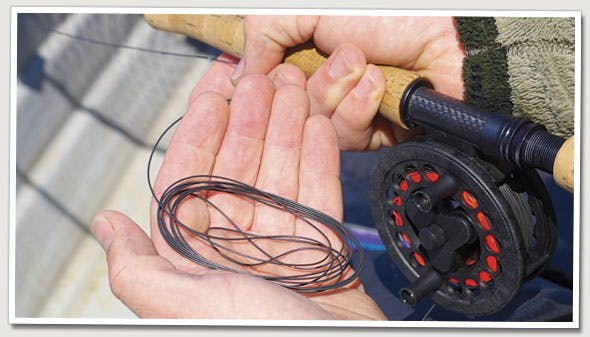
Casting sinking lines
ASINKING line is sometimes viewed as being more difficult to cast than a floater. Different, yes, but understand the mechanics and you can adapt.
Sinking lines have a thinner profile, and will cut through the air more easily than floating lines. This means they develop more speed on the cast, and require a small change in timing – basically, you slow everything down a tad. Master this and you will soon have your sinking line zinging out.
It’s important to know how much line is outside the tip ring when the time comes to recast – this is easy to see with a floater, but with a sinking line it is almost impossible to lift off the same amount of fly line every time.
Asolution is to make small whippings of tying thread on the fly line at points 10 foot and 20 foot from the leader, and coat them with Superglue. This is not a visual indicator. Instead, you can feel the slight check as the whippings come through the tip ring. Retrieve until the last 15-20 foot of line is out, and then attempt to lift off. Asmall roll cast to lift the line closer to the surface will help before you make the next cast proper.
See for yourself
IF you’re one of the many returning to trout fishing after a long lay-off, don’t let old prejudices hold you back from using sinking lines. The modern types are far removed from their predecessors. So get out there and get on down – you won’t regret it!
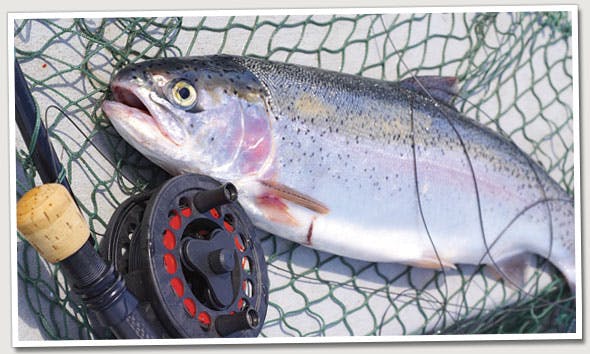
QUICK GUIDE
Which type of sinking line profile is best for bank fishing?
40+ is my first choice for most bank fishing, being very easy to cast long distances. Also the slower sinking running line helps the line follow the natural contour of the lake’s shore.
Does my Di-5 Sixth Sense sink faster than my Di-5 Delta taper line?
The straight answer is no, they both sink at 5 inches per second. However, because of the blue colour of the SS line, it appears to sink faster in the water – this is just a visual.
Why do you offer three different densities of intermediate lines?
We offer 0.5in, 1in and 1.5 inch per second options and whilst they seem close together in sink rate, as a percentage increase in sink speed, they are worlds apart. Generally intermediates are fished at slower pace and on a 30 yard retrieve this can take over 60 seconds – putting your fly at approximately 2ft 6in, 5ft and 7ft 6in at the deepest point of the retrieve.
